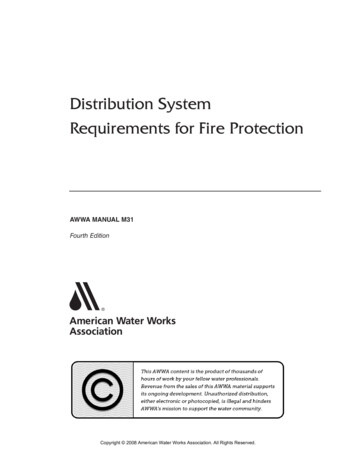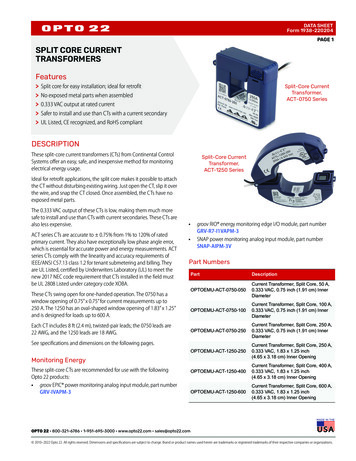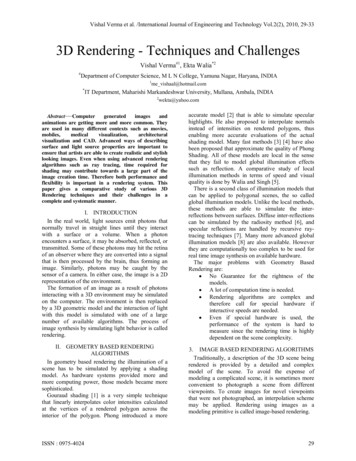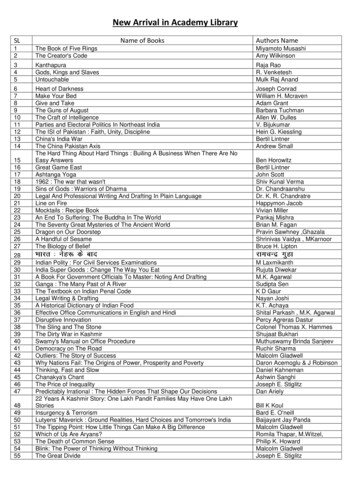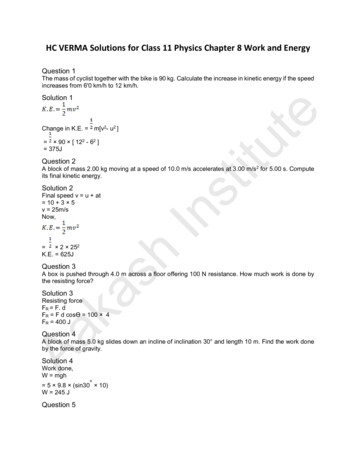
Transcription
HC VERMA Solutions for Class 11 Physics Chapter 8 Work and EnergyQuestion 1The mass of cyclist together with the bike is 90 kg. Calculate the increase in kinetic energy if the speedincreases from 6'0 km/h to 12 km/h.uteSolution 1Change in K.E. m[v2- u2 ] 90 [ 122 - 62 ] 375JtitQuestion 2Solution 2 2 252 K.E. 625JQuestion 3shFinal speed v u at 10 3 5v 25m/sNow,InsA block of mass 2.00 kg moving at a speed of 10.0 m/s accelerates at 3.00 m/s2 for 5.00 s. Computeits final kinetic energy.A box is pushed through 4.0 m across a floor offering 100 N resistance. How much work is done bythe resisting force?kaSolution 3Resisting forceFR F. dFR F d cosƟ 100 4FR 400 JAaQuestion 4A block of mass 5.0 kg slides down an incline of inclination 30 and length 10 m. Find the work doneby the force of gravity.Solution 4Work done,W mgh 5 9.8 (sin30 10)W 245 JQuestion 5
A constant force of 2.50 N accelerates a stationary particle of mass 15 g through a displacement of2.50 m. Find the work done and the average power delivered?Solution 5uteW F.dW Fd cosƟW 2.5 2.5 cosƟW 6.25JNow,v 28.8 m/sAnd F ma 28.8/166.66 0.1728 secAnd average power, Pw Question 6Inst tita 2.5/ 0.015 166.66 m/s2So, v u at 6.25/0.1728 36.1 WA particle moves from a point r (2 m) (3 m) to another point r2 (3 m) (2 m) during which aSolution 6r r2 - r1shcertain force F (5 N) (5 N) acts on it. Find the work done by the force on the particle during thedisplacement. (3 2 ) - (2 3 )r Work done W F rkaW (5 5 ) ( - )W 0Question 7AaA man moves on a straight horizontal road with a block of mass 2 kg in his hand. If he covers a distanceof 40 in with an acceleration of 0.5 m/s2, find the work done by the man on the block during the motion.Solution 7F maW F.dW 1 40W 40 J
Question 8A force F a bx acts on a particle in the x-direction, where a and b are constants. Find the workdone by this force during a displacement from x 0 to d.Solution 8Work done, W 0 dF dx ( F a bx)W (a bd)duteQuestion 9A block of mass 250 g slides down an incline of inclination 37 with a uniform speed. Find the workdone against the friction as the block slides through 1m.Solution 9InsQuestion 10titForce μR and F mg sin Ɵmg sin Ɵ μRWork done W μR cos ƟW mg sin Ɵ cos 0 SW 0.25 9.8 0.60 1 1W 1.5 JAakashA block of mass m is kept over another block of mass M and the system rests on a horizontal surface(figure 8-E1). A constant horizontal force F acting on the lower block produces an acceleration F/2(m M) in the system, the two blocks always move together. (a) Find the coefficient of kinetic frictionbetween the bigger block and the horizontal surface. (b) Find the frictional force acting on the smallerblock. (c) Find the work done by the force of friction on the smaller block by the bigger block during adisplacement d of the system.Solution 10(a) 𝜇𝜇k μk (m M)g(b) Fs μkR (m M)g mgFs (m M)
(c) W Fs dW (m M)Question 11A box weighing 2000 N is to be slowly slid through 20 m on a straight track having friction coefficient0.2 with the box. (a) Find the work done by the person pulling the box with a chain at an angle 9 withthe horizontal. (b) Find the work when the person has chosen a value of 0 which ensures him theminimum magnitude of the force.uteSolution 11(a) R P sin Ɵ 2000 . 1P cos Ɵ - 0.2 R 0 .(2)Solving 1 and 2 equations we get,titP and work done W PS cos ƟW Ins(b) For minimum force,[cosƟ 0.2sinƟ] 0 (from equation 1)Also, W 40000/5 tan Ɵ 40000/5 0.2W 7690 JQuestion 12Solution 12shA block of weight 100 N is slowly slid up on a smooth incline of inclination 37 by a person. Calculatethe work done by the person in moving the block through a distance of 2.0 m, if the driving force is (a)parallel to the incline and (b) in the horizontal direction.AakaForce F mg sinƟF 100 sin370 60N(a) Work done W Fd cosƟW 60 2 cos 0 120 J(b) In triangle ABC, AB 2m, Ɵ 37o
AC h 1.3work done W mghW 100 1.2W 120 JQuestion 13Find the average frictional force needed to stop a car weighing 500 kg in a distance of 25 m if the initialspeed is 72 km/h.Solution 13utev2 - u2 -2asa a 25 8m/s2frictional force F ma 500 8F 4000 NtitQuestion 14Solution 14v2- u2 2asa Question 15sha 25a 8 m/s2Force, F ma 500 8F 4000NInsFind the average force needed to accelerate a car weighing 500 kg from rest to 72 km/h in adistance of 25 m.kaA particle of mass m moves on a straight line with its velocity varying with the distance travelledaccording to the equation v a x, where a is a constant. Find the total work done by all the forcesduring a displacement from x 0 to x d.Solution 15v aAav1 0 and v2 av22 - v21 2a'da' Force F ma (ma2)/2Work done W Fd cosƟW dW Question 16A block of mass 2.0 kg kept at rest on an inclined plane of inclination 37 is pulled up the plane byapplying a constant force of 20 N parallel to the incline. The force acts for one second. (a) Show that
the work done by the applied force does not exceed 40 J. (b) Find the work done by the force of gravityin that one second if the work done by the applied force is 40 J. (c) Find the kinetic energy of the blockat the instant the force ceases to act. Take g 10 m/s2.Solution 16(a) For a free body,Force F mg sinƟ maa utea a 4m/s2s ut at2tits 0 1 4 12s 2mW Fs 20 2W 40 Js s 2W -mgh -mg [s sin370]W -20 1.2W -24JkaK.E. 16 Jsh(c) v u at 4 10v 40 m/sIns(b) W FsQuestion 17AaA block of mass 2.0 kg is pushed down an inclined plane of inclination 37 with a force of 20 N actingparallel to the incline. It is found that the block moves on the incline with an acceleration of 10 m/s2. Ifthe block started from rest, find the work done (a) by the applied force in the first second, (b) by theweight of the block in the first second and (c) by the frictional force acting on the block in the firstsecond. Take g 10 m/s2.Solution 17(a) S ut at2S 0 at2S 5 mWork done W Fs cosƟ 20 5 1W 100 J(b) h S sin Ɵ S sin370 3m
work done, W mgh 2 10 3W 60 J(c) Frictional force Ff mg sinƟand work done W Ff s cosƟW mg sinƟ s sinƟW 20 0.60 5W 60 JQuestion 18uteA 250 g block slides on a rough horizontal table. Find the work done by the frictional force in bringingthe block to rest if it is initially moving at a speed of 40 cm/s. If the friction coefficient between the tableand the block is 0.1, how far does the block move before coming to rest?Solution 18Insa μga 0.1 9.8 0.98 m/s2andv2 - u2 2astitWe know,ma μRs (0 - 0.42)/ 2 0.98s 0.082 mWork doneW -μR sinƟ - 0.1 2.5 0.082 1W - 0.02 JQuestion 19Solution 19shWater falling from a 50 m high fall is to be used for generating electric energy. If 1.8 105 kg of waterfalls per hour and half the gravitational potential energy can be converted into electric energy, howmany 100 W lamps can be lit.kaPotential EnergyP.E. mgh 1.8 105 9.8 50P.E. 882 x 105 J/hrAaElectrical energy P.E. 441 105 J/hrPower P (441 105)/3600P 12.25 103 WNo. of 100W lamps that can be lit (12.25 103)/100Number of lamps 122.5 123Question 20A person is painting his house walls. He stands on a ladder with a bucket containing paint in one handand a brush in other. Suddenly the bucket slips from his hand and falls down on the floor. If the bucketwith the paint had a mass of 6.0 kg and was at a height of 2.0 m at the time it slipped, how muchgravitational potential energy is lost together with the paint?Solution 20Initial P.E. at height h,P.Ei mgh 6 9.8 2 117.6 J
Final P.E. at the floor,P.Ef mgh 0P.E. 117.6 - 0P.E. 117.6 JQuestion 21A projectile is fired from the top of a 40 m high cliff with an initial speed of 50 m/s at an unknown angle.Find its speed when it hits the ground.Solution 21uteBy law of conservation of energymgh m vi2 mvf10 40 502 vf2v vf 57.4 m/sv 58 m/stitQuestion 22Solution 22Question 23shPower, P W/tW P t 460 117.56 .(1)AlsoW F d F 200 .(2)From 1 and 2F (460 117.56)/200 270.3F 270 NInsThe 200 m free style women's swimming gold medal at Seol Olympic 1988 went to Heike Friendrich ofEast Germany when she set a new Olympic record of 1 minute and 57.56 seconds. Assume that shecovered most of the distance with a uniform speed and had to exert 460 W to maintain her speed.Calculate the average force of resistance offered by the water during the swim.kaThe US athlete Florence Griffith-Joyner won the 100 m sprint gold medal at Seol Olympic 1988 settinga new Olympic record of 10.54 s. Assume that she achieved her maximum speed in a very short-timeand then ran the race with that speed till she crossed the line. Take her mass to be 50 kg. (a) Calculatethe kinetic energy of Griffith-Joyner at her full speed. (b) Assuming that the track, the wind etc. offeredan average resistance of one tenth of her weight, calculate the work done by the resistance during therun. (c) What power Griffith-Joyner had to exert to maintain uniform speed?AaSolution 23(a) v 100/10.54 m/sK.E. mv2 50 9.4872K.E. 2250 J(b) Weight mg 50 9.8 -490 Jand work doneW -R d W -4900 J d
(c) Power P P 465 W Question 24A water pump lifts water from a level 10 m below the ground. Water is pumped at a rate of 30 kg/minutewith negligible velocity. Calculate the minimum horsepower the engine should have to do this.Solution 24ute 30 kg/min 0.5kg/sandPower g h 0.5 9.81 10P 49 WHorse power 6.6 10-2 hptitQuestion 25Solution 25Work done W mgh mv2Question 26shW 0.2 9.8 1.5 ( 0.2 32)W 3.84JInsAn unruly demonstrator lifts a stone of mass 200 g from the ground and throws it at his opponent. Atthe time of projection, the stone is 150 cm above the ground and has a speed of 3.00 m/s. Calculatethe work done by the demonstrator during the process. If it takes one second for the demonstrator tolift the stone and throw, what horsepower does he use?In a factory it is desired to lift 2000 kg of metal through a distance of 12 m in 1 minute. Find theminimum horsepower of the engine to be used.Solution 26kaW Fd cosƟW mg cosƟ 2000 10 12 1W 24 104 JP (24 104 )/60 4000WHorse power P/746 4000/746 5.3 hpAaQuestion 27A scooter company gives the following specifications about its product.Weight of the scooter - 95 kgMaximum speed - 60 km/hMaximum engine power - 3.5 hpPick up time to get the maximum speed - 5 sCheck the validity of these specifications.Solution 27Max. acceleration,a a (50/3 - 0)/5 3.33m/s2
ForceF ma 95 3.33F 316.6 NVelocityv (3.5 746)/316.6v 8.2 m/sQuestion 28uteA block of mass 30.0 kg is being brought down by a chain. If the block acquires a speed of 40.0 cm/sin dropping down 2.00 m, find the work done by the chain during the process.Question 29Insv2 - u2 2asa (0.42 - 0)/2 2a 0.04 m/s2ForceF ma - mgandWork doneW Fs cosƟ m(a-g) s cosƟW 30 (0.04 - 9.8) 2 1W -585.5 J -586 JtitSolution 28Solution 29shThe heavier block in an Atwood machine has a mass twice that of the lighter one. The tension in thestring is 16.0 N when the system is set into motion. Find the decrease in the gravitational potentialenergy during the first second after the system is released from rest.kaNet force isT - 2mg 2ma 0 . 1T - mg - ma 0 . 2from equation 1 and 2a a m/s2Now,Aas ut at2s 0 12s Decrease in P.E. mghP.E. (2m - m) 9.8 (2/m)P.E. 19.6 JQuestion 30The two blocks in an Atwood machine have masses 2.0 kg and 3.0 kg. Find the work done by gravityduring the fourth second after the system is released from rest.
Solution 30T - 3g 3a 0 1T - 2g - 2a 0 2Solving equation 1 and 2a m/s2Now,S (2m - 1)tituteS [2 4 -1]h S 6.86 mMassm m1 - m 2m 3 - 2 1kgDecrease in P.E. mghP.E. 1 9.8 6.86P.E. 67 JQuestion 31kashInsConsider the situation shown in figure (8-E2). The system is released from rest and the block of mass1.0 kg is found to have a speed 0.3 m/s after it has descended through a distance of 1 m. Find thecoefficient of kinetic friction between the block and the table.Solution 31AaWork done change in K.E.-μR S mg [ m1v12 m2v22] - 0-μ 40 2 1 10 (4 0.32 1 0.62 )μ 0.12Question 32A block of mass 100 g is moved with a speed of 5.0 m/s at the highest point in a closed circular tubeof radius 10 cm kept in a vertical plane. The cross-section of the tube is such that the block just fits init. The block makes several oscillations inside the tube and finally stops at the lowest point. Find thework done by the tube on the block during the process.
Solution 32Work done by block T.E at A - T.E. at B mv2 mgh -0ute 0.1 52 0.1 10 0.2W 1.45 JWork done by tube - Work done by blockW' -1.45 JQuestion 33A car weighing 1400 kg is moving at a speed of 54 km/h up a hill when the motor stops. If it is just ableto reach the destination which is at a height of 10 m above the point, calculate the work done againstfriction (negative of the work done by the friction).Solution 33titWork done,W K.ET - P.ETInsW (0 mv2) - mghW [ 1400 152] - [1400 9.8 10]W 20300JQuestion 34Solution 34shA small block of mass 200 g is kept at the top of a frictionless incline which is 10 m long and 3.2 mhigh. How much work was required (a) to lift the block from the ground and put it at the top, (b) to slidethe block up the incline? What will be the speed of the block when it reaches the ground, if (c) it fallsoff the incline and drops vertically on the ground (d) it slides down the incline? Take g 10 m/s2.(a) Work done W mgh 0.2 10 3.2 (to lift the block)W 6.4 Jka(b) Work done W mg sinƟ (to slide the block)W 6.4J(c) When block falls on ground work done isAaW m v2 - 06.4 0.2 v2v 8m/s(d) W m v2 - 06.4 0.2 v2v 8 m/sQuestion 35In a children's park, there is a slide which has a total length of 10 m and a height of 8.0 m (figure 8E3). Vertical ladder are provided to reach the top. A boy weighing 200 N climbs up the ladder to the
Solution 35(b) Work done W μRS fd - (200 3/10 ) 10 -600 JIns(c) Work done, W mg sinƟ d 200 8/10 10W 1600 Jtit(a) Work done, W 0 because no work is done by ladder.utetop of the slide and slides down to the ground. The average friction offered by the slide is three tenthof his weight. Find (a) the work done by the ladder on the boy as he goes up, (b) the work done by theslide on the boy as he comes down. Neglect any work done by forces inside the body of the boy.Question 36kashFigure (8-E4) shows a particle sliding on a frictionless track which terminates in a straight horizontalsection. If the particle starts slipping from the point A, how far away from the track will the particle hitthe ground?AaSolution 36By conservation of energy of point A and BmgH m v2 mgh
Question 37Ins-0.5 u sinƟ t (-9.8)t2t 0.31 sand X 4 cosƟ tX 1titS ut a t2uteg 1 v2 g 0.5v 9.8 0.3 m/sAfter B, body obeys projectile motion, soAakashA block weighing 10 N travels down a smooth curved track AB joined to a rough horizontal surface(figure 8-E5). The rough surface has a friction coefficient of 0.20 with the block. If the block startsslipping on the track from a point 1.0 m above the horizontal surface, how far will it move on the roughsurface?Solution 37Work done, W mgh 10 1W 10 JFrictional force, F μR μmg 0.2 10F 2Nand W Fss 5mQuestion 38
A uniform chain of mass in and length l overhangs a table with its two third part on the table. Find thework to be done by a person to put the hanging part back on the table.Solution 38W (m/l) dx g(x)Total work done is :W l/3 0 (m/l) dx g(x)W mgl/18Question 39ituteA uniform chain of length L and mass M overhangs a horizontal table with its two third part on thetable. The friction coefficient between the table and the chain is 11. Find the work done by the frictionduring the period the chain slips off the table.Solution 39stWork done for small element is:dW μRxdw μ(M/L dx) g(x)Total work done is :W 2L/3 0 μ M/L g ( ) dxW (2𝜇𝜇MgL)/9Question 40kashInA block of mass 1 kg is placed at the point A of a rough track shown in figure (8-E6). If slightly pushedtowards right, it stops at the point B of the track. Calculate the work done by the frictional force on theblock during its transit from A to B.Solution 40AaWork done change in P.E.W mgh - mgHW 1 10 (0.8 - 1)W -2 JQuestion 41A block of mass 5.0 kg is suspended from the end of a vertical spring which is stretched by 10 cmunder the load of the block. The block is given a sharp impulse from below so that it acquires anupward speed of 2.0 m/s. How high will it rise? Take g 10 m/s2.Solution 41k (mg)/x 50/0.1 500N/m
Total energy T.E. m v 2 k x2 . (1)andT.E. (at height h) k (h - )2 mgh . (2)Equating 1 and 2 5 22 500 0.12 500 (h - 0.12) 5 10 hh 0.2 mh 20cmQuestion 42itutem v 2 k 2 ½ k (h - x)2 mghA block of mass 250 g is kept on a vertical spring of spring constant 100 N/m fixed from below. Thespring is now compressed to have a length 10 cm shorter than its natural length and the system isreleased from this position. How high does the block rise? Take g 10 m/s2.Solution 42stBy law of conservation of energy: 100 0.1 mgh 0.25 10 hh 0.2mh 20 cmQuestion 43Ink x2 mghAakashFigure (8-E7) shows a spring fixed at the bottom end of an incline of inclination 37 . A small block ofmass 2 kg starts slipping down the incline from a point 4.8 m away from the spring. The blockcompresses the spring by 20 cm, stops momentarily and then rebounds through a distance of 1 m upthe incline. Find (a) the friction coefficient between the plane and the block and (b) the spring constantof the spring. Take g 10m/s2.Solution 43By work energy principle(i) for downward motion,0-0 (-mg sinƟ s) - μRs - kx280μ 0.02R 60 (1)
(ii) for upward motion0 - 0 (-mg sinƟ s) - μRs kx2-16 μ 0.02 k 12 (2)Solving 1 and 2 we get,μ 0.5andk 1000 N/mQuestion 44ituteA block of mass m moving at a speed v compresses a spring through a distance x before its speed ishalved. Find the spring constant of the spring.Solution 44Energy at A Energy at Bm v 2a m vb2 k x2mv2 k x2stk Question 45kashInConsider the situation shown in figure (8-E8). Initially the spring is unstretched when the system isreleased from rest. Assuming no friction in the pulley, find the maximum elongation of the spring.AaSolution 45From figuremgx k x2x Question 46A block of mass m. is attached to two upstretched springs of spring constants k, and k2 as shown infigure (8-E9). The block is displaced towards right through a distance x and is released. Find the speedof the block as it passes through the mean position shown.
ituteSolution 46By law of conservation of energym v2 k1x2 k2x2So, v (k1 k2)/mQuestion 47InstA block of mass m sliding on a smooth horizontal surface with a velocity v meets a long horizontalspring fixed at one end and having spring constant k as shown in figure (8-E10). Find the maximumcompression of the spring. Will the velocity of the block be the same as when it comes back to theoriginal position shown?Solution 47m v2 k x2Max v m/ksh(a) By law of conservation of energy:ka(b) Velocity of the block will not be the same when it comes back to the original position, it will be ofsmaller magnitude and opposite direction.Question 48AaA small block of mass 100 g is pressed against a horizontal spring fixed at one end to compress thespring through 5.0 cm (figure 8-E11). The spring constant is 100 N/m. When released, the block moveshorizontally till it leaves the spring. Where will it hit the ground 2 m below the spring?
ituteSolution 48By law of conservation of energy:Question 49Iny (u sinƟ )t - g t2Ɵ 00 , y -2t 0.63 secandx (u cosƟ)t 1.58 0.63x 1mstmv2 k x2v 1.58 m/s2Now, projectile motionAakashA small heavy block is attached to the lower end of a light rod of length l which can be rotated aboutits clamped upper end. What minimum horizontal velocity should the block be given so that it movesin a complete vertical circle?Solution 49Minimum velocity at A vMinimum velocity at B 0By law of conservation of energy
m v2 mg (2l)v 2 glQuestion 50ituteFigure (8-E12) shows two blocks A and B, each having a mass of 320 g connected by a light stringpassing over a smooth light pulley. The horizontal surface on which the block A can slide is smooth.The block A is attached to a spring of spring constant 40 N/m whose other end is fixed to a support 40cm above the horizontal surface. Initially, the spring is vertical and upstretched when the system isreleased to move. Find the velocity of the block A at the instant it breaks off the surface below it. Takeg 10 m/s2.from figurekx cosƟ mg40 x X x (0.4/[0.4 x]) 0.32 10x 0.1mandS (h x)-h2 [(0.4 0.1)2 - 0.42]S 0.3mChange in K.E. Work donemv2 - kx2 mgsIn 0.32 v2 - x 40 0.12 0.32 10 0.3v 1.5 m/sstSolution 50Question 51AakashOne end of a spring of natural length h and spring constant k is fixed at the ground and the other isfitted with a smooth ring of mass m which is allowed to slide on a horizontal rod fixed at a heighth (figure 8-E13). Initially, the spring makes an angle of 37 with the vertical when the system is releasedfrom rest. Find the speed of the ring when the spring becomes vertical.Solution 51cosƟ cos37 BC/AC 4/5AC (h x) and x AC - h -h By work energy principle,k x2 m v2
v Question 52InstituteFigure (8-E14) shows a light rod of length 1 rigidly attached to a small heavy block at one end and ahook at the other end. The system is released from rest with the rod in a horizontal position. There isa fixed smooth ring at a depth h below the initial position of the hook and the hook gets into the ringas it reaches there. What should be the minimum value of h so that the block moves in a completecircle about the ring?Solution 52vmin 2glTotal energy at A Total energy at BQuestion 53shmgh m v2 [v 2gl]h lkaThe bob of a pendulum at rest is given a sharp hit to impart a horizontal velocity .V10 gl, where 1 isthe length of the pendulum. Find the tension in the string when (a) the string is horizontal, (b) the bobis at its highest point and (c) the string makes an angle of 60 with the upward vertical.Solution 53(a) By law of conservation of energy,Aamv12 m v22 mgl m ( gl )2 m v22 mglv2 ( 8gl)andTB (mv22)/R [m ( 8gl)2]/lTB 8mg(b) By law of conservation at A and Cmv12 m v32 mgh ( logl)2 v32 g 2lv3 ( 6gl)
andTensionTc [ (mv32)/l ] - mgTc 5mg(c) By law of conservation of energy at A and Dmv12 m v42 mghitute( logl)2 m v42 gl (1 cos600)v4 7glandTensionTD (mv2)/l - mg cos600by putting v 7gl we get,TD 6.5mgQuestion 54Solution 54from figure,shInstA simple pendulum consists of a 50 cm long string connected to a 100 g ball. The ball is pulled asideso that the string makes an angle of 37 with the vertical and is then released. Find the tension in thestring when the bob is at its lowest position.AakacosƟ andAC AB cosƟAC 0.4andCD AD -ACCD 0.1 mEnergy is same at B and Dm v2 mghv2 10 0.1v m/sTension T (mv2)/r mgT (0.1 2)/0.5 0.1 10T 1.4 NQuestion 55Figure (8-E15) shows a smooth track, a part of which is a circle of radius R. A block of mass m ispushed against a spring of spring constant k fixed at the left end and is then released. Find the initial
compression of the spring so that the block presses the track with a force mg when it reaches the pointP, where the radius of the track is horizontal.Solution 55According to figure,(mv2)/R mgv Energy is same at A and Pitutekx2 x Question 56The bob of a stationary pendulum is given a sharp hit to impart it a horizontal speed of 3gl. Find theangle -rotated by the string before it becomes slack.Solution 56m v2 - mu2 -mgh 3gl - 2gl (1 cosƟ) . 1and(mv2)/l mg cosƟv2 gl cosƟ 2from equation 1 and 23gl - 2gl - 2gl cosƟ gl cosƟstChange in K.E. is given asshθ cos-1( )Thus,Inv2Angle 1800 - cos-1 ( )Angle cos-1 (-1/3)Question 57kaA heavy particle is suspended by a 1.5 m long string. It is given a horizontal velocity of 57 m/s. (a)Find the angle made by the string with the upward vertical, when it becomes slack. (b) Find the speedof the particle at this instant. (c) Find the maximum height reached by the particle over the point ofsuspension. Take g 10 m/s2.Solution 57Aa(a) mg cosƟ (mv2)/lv ( gl cosƟ) . 1Change in K.E. is given as :mv2 - mu2 mghv2 - ( 57)2 g (1.5[ 1 cosƟ])v ( 57 - 3g(1 cosƟ) . 2from equation 1 and 21.5 g cosƟ 57 - 3g (1 cosƟ)Ɵ 530
(b) v 57 - 3g (1 cosƟ) Ɵ 53v 3m/s(c) After, point B projectile motion will take placeH OE DCH 1.5 cosƟ (u2sin2Ɵ)/2 gH 1.5 (9 0.82)/2 10H 1.2mituteQuestion 58Solution 58shInstA simple pendulum of length L having a bob of mass m is deflected from its rest position by an angle9 and released (figure 8-E16). The string hits a peg which is fixed at a distance x below the point ofsuspension and the bob starts going in a circle centred at the peg. (a) Assuming that initially the bobhas a height less than the peg, show that the maximum height reached by the bob equals its initialheight. (b) If the pendulum is released with Ɵ 90 and x L/2 find the maximum height reached bythe bob above its lowest position before the string becomes slack. (c) Find the minimum value of x/Lfor which the bob goes in a complete circle about the peg when the pendulum is released from Ɵ 90 .AakaTotal energy at A and B are same
itutestInK.EA P.EA K.EB P.EBwe get,P.EA P.EBThus maximum height is same as initial height.Aakash(b)At C, ½ mvc2 - 0 mg (L/2)(1 - cos )Vc ( gL (1-cos )) . 1Again,Vc ( gL cos ) . 2equating 1 and 2cos ⅔ 3
Now, BF cos BF (5L/6)Question 59sh(mvc2)/L-x mgvc ( g (L-x)) . 1Also,½ mvc2 - 0 mg (OC)vc ( 2g (2x-L)) . 2Equating 1 and 2g (L-x) 2g (2x - L)x/L 0.6Institute(c)kaA particle slides on the surface of a fixed smooth sphere starting from the topmost point. Find theangle rotated by the radius through the particle, when it leaves contact with the sphere.Solution 59AaFrom figure,(mv2)/R mg cosƟv ( gRcosƟ) . 1andChange in K.E. Work donem v2 - 0 mg (R - R cosƟ)v ( 2gR [1-cosƟ]) . 2from 1 and 2gR cosƟ 2gR (1-cosƟ)Ɵ cos-1( )Question 60
A particle of mass m is kept on a fixed, smooth sphere of radius R at a position, where the radiusthrough the particle makes an angle of 30 with the vertical. The particle is released from this position.(a) What is the force exerted by the sphere on the particle just after the release? (b) Find the distancetravelled by the particle before it leaves contact with the sphere.Solution 60(a) Net force mg cosƟ 3/2 mg(b) N 0anditute mg cosƟv ( gR cosƟ) .1andmv2 mgR (cos30 - cosƟ)v ( 2gR 3/2 - cosƟ]) . 2from equation 1 and 2 we get,stƟ cos-1( )and distance , l R [Ɵ - π/6]l 0.43RQuestion 61kashInA particle of mass m is kept on the top of a smooth sphere of radius R. It is given a sharp impulsewhich imparts it a horizontal speed v. (a) Find the normal force between the sphere and the particlejust after the impulse. (b) What should be the minimum value of v for which the particle does not slipon the sphere? (c) Assuming the velocity v to be half the minimum calculated in part, (b) Find the anglemade by the radius through the particle with the vertical when it leaves the sphere.Solution 61Aa(a) from free body diagramN mg - (mv2)/R(b) When particle moves with maximum velocity then,mg (mv2)/Rv gR
(c ) From figure,v1 ( gR)/2 . 1and(mv22)/R mg cosƟv2 ( gR cosƟ) 2Also, change in K.E. Work doneitutem v22 - m v1 mgR (1 - cosƟ) 3from equation 2 and 3gR cosƟ v12 2gR (1 - cosƟ)Ɵ cos-1( )Chapter 8 - Work and Energy Exercise 137Question 62stFigure (8-E17) shows a smooth track which consists of a straight inclined part of length 1 joiningsmoothly with the circular part. A particle of mass m is projected up the incline from its bottom. (a) Findthe minimum projection-speed v, for which the particle reaches the top of the track. (b) Assuming thatthe projection-speed is 2v0 and that the block does not lose contact with the track before reaching itstop, find the force acting on it when it reaches the top. (c) Assuming that the projection-speed is onlyslightly greater than 2v0, where will the block lose contact with the track?sh(a) FAB mg sinƟWB FABSWB mg sinƟ l . 1andWC mgR(1-cosƟ) . 2Total work doneW W B W Candchange in K.E. Work donev0 [ 2g(R (1-cosƟ) l sinƟ]InSolution 62Aaka(b) By work energy equationchange in K.E. Work donevc [ 6g (l sinƟ) R (1-cosƟ) ]andForce,F (m vc2)/RF 6mg (l/R sinƟ 1-cosƟ)(c) (mv2)/R mg cosƟv gR cosƟ . 1Also,v [ 2gR (1-cosƟ)] . 2equating 1 and 2 we get,Ɵ cos-1 ( )Question 63A chain of length 1 and mass m lies on the surface of a smooth sphere of radius R 1 with one endtied to the top of the sphere. (a) Find the gravitational potential energy of the chain with reference level
at the centre of the sphere. (b) Suppose the chain is released and slides down the sphere. Find thekinetic energy of the chain, when it has slid through an angle 9. (c) Find the tangential accelerationdv/dt of the chain when the chain starts sliding down.Solution 63(a) G.P.E dm g R cosƟ (mgR cosƟ dƟ)/l [dm m/l R dƟ]Total G.P.E 0 l/r(mgR2)/l cosƟ dƟ [Ɵ l/R]G.P.E (mgR2)/l sin(l/R)itute(b) K.E. change in P.EK.E. (mgR2)/l [sin (l/R) sinƟ - sin (Ɵ l/R)](c) From above equationK.E. (mgR2)/l [sin (l/R)
s (0 - 0.4. 2)/ 2 0.98 . s 0.082 m . Work done . W - 0.02 J . Question 19 . Water falling from a 50 m high fall is to be used for generating electric energy. If 1.8 10. 5. kg of water falls per hour and half the gravitational potential energy can be converted into electric




